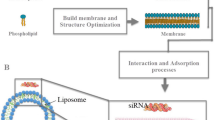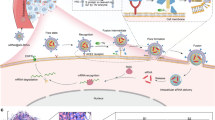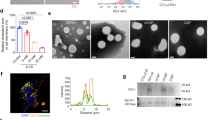Abstract
Efficient cytosolic delivery is a significant hurdle when using short interfering RNA (siRNA) in therapeutic applications. Here we show that cholesterol-rich exosomes are prone to entering cancer cells through membrane fusion, achieving direct cytosolic delivery of siRNA. Molecular dynamics simulations suggest that deformation and increased contact with the target cell membrane facilitate membrane fusion. In vitro we show that cholesterol-enriched milk-derived exosomes (MEs) achieve a significantly higher gene silencing effect of siRNA, inducing superior cancer cell apoptosis compared with the native and cholesterol-depleted MEs, as well as conventional transfection agents. When administered orally or intravenously to mice bearing orthotopic or subcutaneous tumours, the cholesterol-enriched MEs/siRNA exhibit antitumour activity superior to that of lipid nanoparticles. Collectively, by modulating the cholesterol content of exosome membranes to facilitate cell entry via membrane fusion, we provide a promising approach for siRNA-based gene therapy, paving the way for effective, safe and simple gene therapy strategies.
This is a preview of subscription content, access via your institution
Access options
Access Nature and 54 other Nature Portfolio journals
Get Nature+, our best-value online-access subscription
$32.99 / 30 days
cancel any time
Subscribe to this journal
Receive 12 print issues and online access
$259.00 per year
only $21.58 per issue
Buy this article
- Purchase on SpringerLink
- Instant access to full article PDF
Prices may be subject to local taxes which are calculated during checkout






Similar content being viewed by others
Data availability
All data supporting the findings of this study are included in the article and the Supplementary Information. There are no data from third-party or publicly available datasets. All data generated as part of this study are available from the corresponding author upon reasonable request. Source data are provided with this paper.
References
Hu, B. et al. Thermostable ionizable lipid-like nanoparticle (iLAND) for RNAi treatment of hyperlipidemia. Sci. Adv. 8, eabm1418 (2022).
Zhao, J. H. & Guo, H. S. RNA silencing: from discovery and elucidation to application and perspectives. J. Integr. Plant Biol. 64, 476–498 (2022).
Chen, Y. et al. Targeting Xkr8 via nanoparticle-mediated in situ co-delivery of siRNA and chemotherapy drugs for cancer immunochemotherapy. Nat. Nanotechnol. 18, 193–204 (2023).
Chen, X. et al. RNA interference-based therapy and its delivery systems. Cancer Metast. Rev. 37, 107–124 (2018).
Kanasty, R., Dorkin, J. R., Vegas, A. & Anderson, D. Delivery materials for siRNA therapeutics. Nat. Mater. 12, 967–977 (2013).
Kim, B., Park, J. H. & Sailor, M. J. Rekindling RNAi therapy: materials design requirements for in vivo siRNA delivery. Adv. Mater. 31, e1903637 (2019).
Jiang, X. et al. Oral delivery of nucleic acid therapeutics: challenges, strategies, and opportunities. Drug Discov. Today 28, 103507 (2023).
Liang, J. et al. Sphk2 RNAi nanoparticles suppress tumor growth via downregulating cancer cell derived exosomal microRNA. J. Control. Release 286, 348–357 (2018).
Zhou, X. et al. Tumour-derived extracellular vesicle membrane hybrid lipid nanovesicles enhance siRNA delivery by tumour-homing and intracellular freeway transportation. J. Extracell. Vesicles 11, e12198 (2022).
Zhuang, J. et al. Targeted gene silencing in vivo by platelet membrane-coated metal-organic framework nanoparticles. Sci. Adv. 6, eaaz6108 (2020).
Dammes, N. et al. Conformation-sensitive targeting of lipid nanoparticles for RNA therapeutics. Nat. Nanotechnol. 16, 1030–1038 (2021).
Blaby-Haas, C. E. & Merchant, S. S. Lysosome-related organelles as mediators of metal homeostasis. J. Biol. Chem. 289, 28129–28136 (2014).
Uddin, N., Binzel, D. W., Shu, D., Fu, T.-M. & Guo, P. Targeted delivery of RNAi to cancer cells using RNA-ligand displaying exosome. Acta. Pharm. Sin. B 13, 1383–1399 (2023).
Han, K. et al. A tumor targeted chimeric peptide for synergistic endosomal escape and therapy by dual-stage light manipulation. Adv. Funct. Mater. 25, 1248–1257 (2015).
Wittrup, A. et al. Visualizing lipid-formulated siRNA release from endosomes and target gene knockdown. Nat. Biotechnol. 33, 870–876 (2015).
Gilleron, J. et al. Image-based analysis of lipid nanoparticle-mediated siRNA delivery, intracellular trafficking and endosomal escape. Nat. Biotechnol. 31, 638–646 (2013).
Miller, J. B. & Siegwart, D. J. Design of synthetic materials for intracellular delivery of RNAs: from siRNA-mediated gene silencing to CRISPR/Cas gene editing. Nano Res. 11, 5310–5337 (2018).
Selby, L. I., Cortez-Jugo, C. M., Such, G. K. & Johnston, A. P. R. Nanoescapology: progress toward understanding the endosomal escape of polymeric nanoparticles. Wiley Interdiscip. Rev. Nanomed. Nanobiotechnol. 9, e1452 (2017).
Zhang, Y. et al. An antigen self-assembled and dendritic cell-targeted nanovaccine for enhanced immunity against cancer. Acta. Pharm. Sin. B 13, 3518–3534 (2023).
Kamerkar, S. et al. Exosomes facilitate therapeutic targeting of oncogenic KRAS in pancreatic cancer. Nature 546, 498–503 (2017).
Herrmann, I. K., Wood, M. J. A. & Fuhrmann, G. Extracellular vesicles as a next-generation drug delivery platform. Nat. Nanotechnol. 16, 748–759 (2021).
Kalluri, R. & LeBleu, V. S. The biology, function, and biomedical applications of exosomes. Science 367, eaau6977 (2020).
Mathieu, M., Martin-Jaular, L., Lavieu, G. & Théry, C. Specificities of secretion and uptake of exosomes and other extracellular vesicles for cell-to-cell communication. Nat. Cell Biol. 21, 9–17 (2019).
Mulcahy, L. A., Pink, R. C. & Carter, D. R. Routes and mechanisms of extracellular vesicle uptake. J. Extracell. Vesicles 3, 24641 (2014).
Tian, T. et al. Exosome uptake through clathrin-mediated endocytosis and macropinocytosis and mediating miR-21 delivery. J. Biol. Chem. 289, 22258–22267 (2014).
Cui, L. et al. Vesicle trafficking and vesicle fusion: mechanisms, biological functions, and their implications for potential disease therapy. Mol. Biomed. 3, 29 (2022).
Hindi, S. M. et al. Enveloped viruses pseudotyped with mammalian myogenic cell fusogens target skeletal muscle for gene delivery. Cell 186, 2062–2077.e17 (2023).
Ji, X. et al. In situ cell membrane fusion for engineered tumor cells by worm-like nanocell mimics. ACS Nano 14, 7462–7474 (2020).
Chen, P. et al. A plant-derived natural photosynthetic system for improving cell anabolism. Nature 612, 546–554 (2022).
Ho, N. T. et al. Membrane fusion and drug delivery with carbon nanotube porins. Proc. Natl Acad. Sci. USA 118, e2016974118 (2021).
Zheng, Z., Li, Z., Xu, C., Guo, B. & Guo, P. Folate-displaying exosome mediated cytosolic delivery of siRNA avoiding endosome trapping. J. Control. Release 311–312, 43–49 (2019).
Sanders, D. W. et al. SARS-CoV-2 requires cholesterol for viral entry and pathological syncytia formation. eLife 10, e65962 (2021).
Wang, C. et al. Different regions of synaptic vesicle membrane regulate VAMP2 conformation for the SNARE assembly. Nat. Commun. 11, 1531 (2020).
Nakato, M. et al. ABCA13 dysfunction associated with psychiatric disorders causes impaired cholesterol trafficking. J. Biol. Chem. 296, 100166 (2021).
Allen, J. A., Halverson-Tamboli, R. A. & Rasenick, M. M. Lipid raft microdomains and neurotransmitter signalling. Nat. Rev. Neurosci. 8, 128–140 (2007).
Linetti, A. et al. Cholesterol reduction impairs exocytosis of synaptic vesicles. J. Cell Sci. 123, 595–605 (2010).
Lötvall, J. et al. Minimal experimental requirements for definition of extracellular vesicles and their functions: a position statement from the International Society for Extracellular Vesicles. J. Extracell. Vesicles 3, 26913 (2014).
Düzgüneş, N. & Nir, S. Mechanisms and kinetics of liposome-cell interactions. Adv. Drug Deliv. Rev. 40, 3–18 (1999).
Kong, L., Askes, S. H. C., Bonnet, S., Kros, A. & Campbell, F. Temporal control of membrane fusion through photolabile PEGylation of liposome membranes. Angew. Chem. Int. Ed. 55, 1396–1400 (2016).
Skotland, T., Hessvik, N. P., Sandvig, K. & Llorente, A. Exosomal lipid composition and the role of ether lipids and phosphoinositides in exosome biology. J. Lipid Res. 60, 9–18 (2019).
Arnarez, C. et al. Dry Martini, a coarse-grained force field for lipid membrane simulations with implicit solvent. J. Chem. Theory Comput. 11, 260–275 (2015).
Samuel, M. et al. Oral administration of bovine milk-derived extracellular vesicles induces senescence in the primary tumor but accelerates cancer metastasis. Nat. Commun. 12, 3950 (2021).
Ziolkowski, W. et al. Methyl-beta-cyclodextrin induces mitochondrial cholesterol depletion and alters the mitochondrial structure and bioenergetics. FEBS Lett. 584, 4606–4610 (2010).
Chabanel, A. et al. Influence of cholesterol content on red cell membrane viscoelasticity and fluidity. Biophys. J. 44, 171–176 (1983).
Li, M. et al. Nanoscale imaging and mechanical analysis of Fc receptor-mediated macrophage phagocytosis against cancer cells. Langmuir 30, 1609–1621 (2014).
Zheng, D. W. et al. Hierarchical micro-/nanostructures from human hair for biomedical applications. Adv. Mater. 30, e1800836 (2018).
Qiu, Y. et al. Yolk-shell cationic liposomes overcome mucus and epithelial barriers for enhanced oral drug delivery. Giant 17, 100221 (2024).
Wang, X. et al. Efficient base editing in methylated regions with a human APOBEC3A-Cas9 fusion. Nat. Biotechnol. 36, 946–949 (2018).
Zhao, E. et al. Spatial transcriptomics at subspot resolution with BayesSpace. Nat. Biotechnol. 39, 1375–1384 (2021).
Xue, C. et al. Programmably tiling rigidified DNA brick on gold nanoparticle as multi-functional shell for cancer-targeted delivery of siRNAs. Nat. Commun. 12, 2928 (2021).
Liu, H.-J. et al. Integrated combination treatment using a ‘smart’ chemotherapy and microRNA delivery system improves outcomes in an orthotopic colorectal cancer model. Adv. Funct. Mater. 28, 1801118 (2018).
Acknowledgements
We sincerely appreciate the financial support from the National Science Fund of Distinguished Young Scholars (82025032), the National Key Research and Development Program of China (2022YFA1203200), the National Natural Science Foundation of China (82073773), the Young Elite Scientists Sponsorship Program by CAST (2022QNRC001), the Key Research Program of Chinese Academy of Sciences (ZDBS-ZRKJZ-TLC005), the ‘Open Competition to Select the Best Candidates’ Key Technology Program for Nucleic Acid Drugs of NCTIB (NCTIB2022HS01006), the Shanghai Action Plan for Science, Technology and Innovation (23HC1401200) and the Shanghai Institute of Materia Medica, Chinese Academy of Sciences (SIMM0220232001). We thank the staff members of the Integrated Laser Microscopy System, the Electron Microscopy System, the Molecular Imaging System and the Large-scale Protein Preparation System at the National Facility for Protein Science in Shanghai (NFPS), Shanghai Advanced Research Institute, Chinese Academy of Sciences, China, for sample preparation, data collection and analysis. The MD simulations were performed on BSCC-A6 at the Beijing Super Cloud Computing Center. We are grateful to G. Li, Y. Yu, F. Gong and F. Liu for cryo-TEM data collection, cell imaging and AFM data collection, respectively.
Author information
Authors and Affiliations
Contributions
M.Y., G.H., Y.G., Y.Z. and Z.L. planned and executed the experiments, analysed the data and were involved in discussions of the data. M.Y., G.H., Y.Z., Z.L. and Z. Zhu wrote the paper. Y.Z., Z.L., Z. Zhu, J.W., X.L., Z. Zhang, C.G., B.W. and D.N. performed the experiments. All authors critically reviewed and approved the paper.
Corresponding authors
Ethics declarations
Competing interests
The authors declare no competing interests.
Peer review
Peer review information
Nature Nanotechnology thanks the anonymous reviewers for their contribution to the peer review of this work.
Additional information
Publisher’s note Springer Nature remains neutral with regard to jurisdictional claims in published maps and institutional affiliations.
Supplementary information
Supplementary Information
Supplementary Discussion, Methods, Table 1, Figs. 1–22 and References.
Supplementary Video 1
Uptake of 5%Chol/MEs in HCT116 cells.
Supplementary Video 2
Uptake of 30%Chol/MEs in HCT116 cells.
Supplementary Video 3
3D distribution of 5%Chol/MEs in HCT116 cells.
Supplementary Video 4
3D distribution of 30%Chol/MEs in HCT116 cells.
Supplementary Data 1
Uncropped and unprocessed scans for Supplementary Fig. 2.
Supplementary Data 2
Uncropped and unprocessed scans for Supplementary Fig. 4.
Source data
Source Data Fig. 1
Statistical source data for Fig. 1a,c,e,f,i.
Source Data Fig. 2
Statistical source data for Fig. 2b,c,f,h–j.
Source Data Fig. 3
Statistical source data for Fig. 3c,e,f.
Source Data Fig. 4
Statistical source data for Fig. 4b–d,f.
Source Data Fig. 4
Unprocessed western blots for Fig. 4c.
Source Data Fig. 5
Statistical source data for Fig. 5b,c,e.
Source Data Fig. 6
Statistical source data for Fig. 6b,d,e.
Rights and permissions
Springer Nature or its licensor (e.g. a society or other partner) holds exclusive rights to this article under a publishing agreement with the author(s) or other rightsholder(s); author self-archiving of the accepted manuscript version of this article is solely governed by the terms of such publishing agreement and applicable law.
About this article
Cite this article
Zhuo, Y., Luo, Z., Zhu, Z. et al. Direct cytosolic delivery of siRNA via cell membrane fusion using cholesterol-enriched exosomes. Nat. Nanotechnol. 19, 1858–1868 (2024). https://doi.org/10.1038/s41565-024-01785-0
Received:
Accepted:
Published:
Issue date:
DOI: https://doi.org/10.1038/s41565-024-01785-0
This article is cited by
-
Mesenchymal stem cell-derived exosomes: an emerging therapeutic strategy for hepatic ischemia-reperfusion injury
Stem Cell Research & Therapy (2025)
-
Nano-formulations in disease therapy: designs, advances, challenges, and future directions
Journal of Nanobiotechnology (2025)
-
Therapeutic potential of naïve and engineered milk extracellular vesicles
Health Nanotechnology (2025)
-
Bioengineered nanovesicles for efficient siRNA delivery through ligand-receptor-mediated and enzyme-controlled membrane fusion
Nature Communications (2025)
-
Delivering RNA through exosomes for cancer therapy
Journal of Nanoparticle Research (2025)



